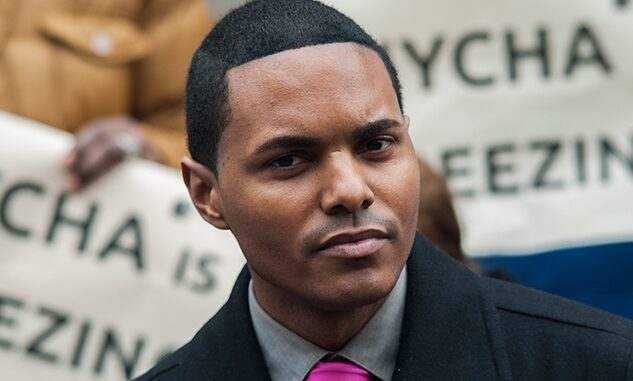
By Eric Klein
[email protected]
After more than a decade of taxpayer waste and mismanagement at the Bronx Hall of Justice, Councilman Ritchie Torres’ announcement of an official investigative referral doubled as a stinging rebuke—not just of the bureaucracies responsible for building and maintaining the troubled courthouse, but also of the oversight system that allowed its problems to go unchecked.
“The public has a right to know why….hundreds of millions of their tax dollars has been so badly spent, and why this massive complex was so poorly planned and so poorly constructed,” Torres told reporters Friday at a press conference in front of the property’s civic plaza.
The sprawling courtyard was erected eleven years ago. Yet it remains closed today, perpetually under construction, most of it covered in tarp and building supplies.
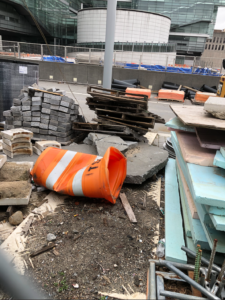
The city painted a much different picture of the site a decade ago.
In 2009, authorities assured Bronxites the plaza would be opened by the end of then year, ready to serve as a bucolic, tree-lined, community gathering place in a neighborhood short on them.
But as a Bronx Justice News investigation revealed last month, those promises weren’t kept.
Torres’ move to bring accountability to the property came in response to our reporting, which revealed wasted tax funds, a host of infrastructure problems, and construction delays.
“The public has a right to know the truth, and as the Investigations Chair I am committed to getting the truth,” Torres said.
Gone, the councilman suggested, are the days when those charged with oversight of the property turn a blind eye to its troubles.
“This is a new day,” Torres said. “The city council is going to be aggressive in holding DCAS and DDC accountable.”
Watch video of Friday’s press conference
There should be plenty of blame to go around.
The Hall of Justice is owned and maintained by the city, with the Department of Citywide Administrative Services responsible for day-to-day facilities management. The project’s construction was overseen by the state Dormitory Authority. And the city’s Department of Design and Construction is overseeing an ongoing $40 million renovation project to address a host of infrastructure problems at the building.
Among them: issues with the heating, cooling, and ventilation systems, as well as “conditions that are causing interior glass to break, removal and replacement of defective paint, repair of damaged ductwork in the garage area, and rehabbing of the building’s sewer line and plumbing vent line,” a DDC spokesman said.
And those are just the latest problems.
Designed by renowned architect Rafael Viñoly, the building’s arrival helped spur economic revitalization in the surrounding community: a bustling Starbucks recently opened across the street, a craft beer bar set up shop around the corner, and rents are rising amid a local construction boom, even as gun violence, poverty, and gang-related crime continue to plague the area.
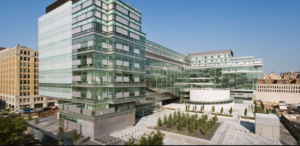
Credit: Rafael Viñoly Architects
But behind the building’s gleaming exterior lay a troubling history—one that began almost as soon as Mayor Rudolph Giuliani broke ground on the project in August 2001.
Construction ran three years behind schedule and $100 million over budget. The lowest-bidding contractor was disqualified because of suspected mob ties, and testing revealed soil at at the construction site to be contaminated with oil, spurring cost overruns and delays.
Just a few years after opening, the Hall of Justice was already involved in a host of lawsuits involving more than 30 parties, from government agencies and builders to engineers and contractors.
The problems didn’t end there: a construction worker pouring concrete at the construction site was killed, the building’s supposedly bomb-proof glass panels were regularly damaged, and a 75-foot canopy at the courthouse’s entrance was removed after inspectors deemed it unstable. The initial inspectors who improperly signed off on the canopy work were not certified, officials said at the time.
The matter was referred to the Bronx District Attorney’s Office and U.S. Attorney’s Office in 2007, but no charges were ever brought.
The late-2000s saw more problems: Roof leaks, flooding, mold, power outages, and broken elevators and escalators.
The project’s construction manager, Bovis Lend Lease, used numerous contractors at the site. The company, one of the world’s largest construction firms, admitted to a massive over billing scheme on New York projects in 2012. They were hit with $56 million in fines and restitution fees as a result.
City officials, including former Bronx Councilman G. Oliver Koppell, called for an official city investigation of the project. But one was never opened.
Torres said he’s changing that.
He announced a two-pronged plan for getting answers about how, and why, so much has gone wrong at the property. First, he will make a referral to the Department of Investigation—over which his committee has jurisdiction—a move that automatically triggers a DOI probe under city law.
Second, Torres said, he will write laws into the new city budget making funding for DCAS contingent on its providing a plan and timeline for opening the civic plaza; creating a plan to keep it safe; and releasing data about maintenance and repair costs at the 775,000-square-foot property, which Torres called “a $421 million debacle.”
Like much else about the Hall of Justice, the dollar figure cited by the Councilman has a complicated history.
While officials estimated construction costs at $421 million when the courthouse opened, no precise, official figure has been publicly released. The construction manager who completed the building, Hill International, put the project’s value at $450 million. Genesys Engineering, another company involved in building the courthouse, put it at $700 million.
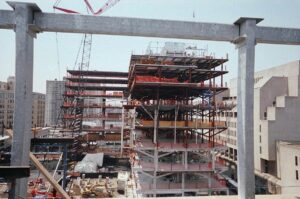
The state Dormitory Authority this week declined to make public the amount of taxpayer funds spent to construct the Hall of Justice, including expenditures on the civic plaza and rooftop rock garden, which also remains closed to visitors.
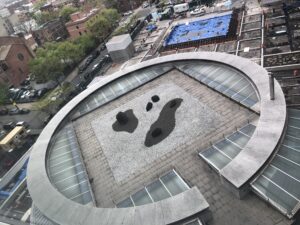
In response, Bronx Justice News submitted a Freedom of Information Law request Wednesday afternoon. Under state law, the agency has five days from the submission date to respond.
Torres said he will hold a budget hearing on city expenditures on the courthouse in May, and alert DOI Commissioner Margaret Garnett that the investigation is a priority for his committee.
As for state oversight, the office of State Comptroller Thomas P. DiNapoli—New York’s chief fiscal officer and the government official tasked with ensuring state and local governments use taxpayer money effectively and efficiently—has been monitoring Bronx Justice News’ coverage. The comptroller has not said whether he plans to probe state expenditures at the Hall of Justice.
As Torres spoke outside the courthouse Friday, several passerby stopped to listen. Among them was Nicole James, 46, a local who’s watched with dismay as the civic plaza remained closed, year after year, despite promises of city officials to open it.
“It’s a shame how much money they wasted here,” said James, referring to the estimated $100 million in cost overruns. “It could have gone to so many things.”
“I’m glad he’s doing this,” she said of Torres.
Many employees inside the building were glad, too.
New York State Supreme Court Officers Association President Patrick Cullen, who is assigned to the Hall of Justice, said Torres’ effort to get answers are a welcome change.
“It make a difference to our people,” Cullen said.
For Torres, accountability will also mean tangible benefits for Bronxites.
“The public was promised a world-class public square,” he said. “We should get them one.”
Kevin Deutsch and Sasha Gonzales contributed reporting.
